I’ve Seen You Somewhere Before: Soulmates in Ophuls’s Letter from an Unknown Woman
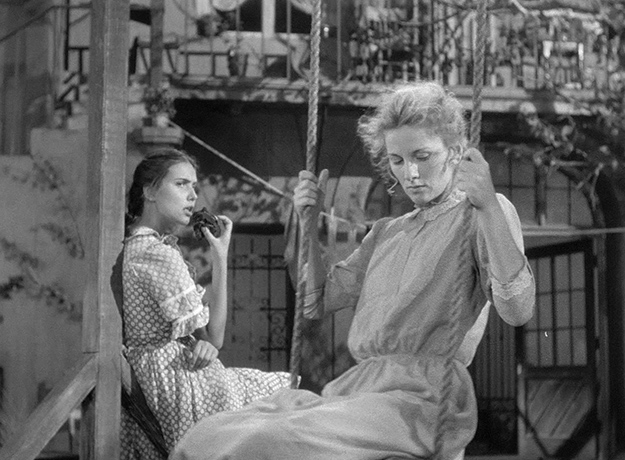
“I think everyone has two birthdays, the day of his physical birth and the beginning of his conscious life.” With these words, Lisa Berndle, the heroine of Max Ophuls’s Letter from an Unknown Woman, is reborn as a votary of romantic love. Beginning when Lisa is a shy and scrawny 14-year-old (convincingly played by a 30-year old-Joan Fontaine), the story of that consuming passion comes to us in the form of a letter, sent to the object of her obsession, a musician who has also, without remembering, been her one-night lover. Stefan Brand, played by a devastatingly handsome Louis Jourdan, has come from a night of carousing only to find himself challenged to a duel. Debonair, a weary libertine (“You know how I hate to get up in the morning”), he plans to skip town until his manservant gives him the letter. He reads through the night, as Fontaine’s melodious (and subtly aging) voice guides us via flashback through the long, lonely voyage of that “conscious life,” catapulted into being in a single rapturous moment. In the novella by Stefan Zweig, from which the movie is adapted, the unnamed woman says —“I will tell you the whole story of my life, and it is a life that truly began only on the day I met you.”
The story of a transformative love, a staple of classic romantic cinema, is given its ravishing apotheosis in this film by Max Ophuls—at once opulent and austere, underrated in its time, but belatedly recognized as one of the glories of the so-called woman’s melodrama. In the seventies and eighties, critics and feminists took another look at those thirties and forties “weepers” that enshrined women’s love and sacrifice, hitherto objects of critical condescension, and saw a fascinating counterpart to male-dominated genres and action films. In the woman’s film, the heroine, far from being merely the pliant object of male desire, or the conventional “little woman,” was maestra and generalissima in the arena of love, someone who risked opprobrium and defined a path for herself outside the traditional bounds of society. When I wrote about Ophuls’s great Earrings of Madame de in the seventies, I quoted Simone de Beauvoir on the women in Stendhal, whom she called the militarists of love. Such heroines risk everything—family, a place in society, respect—in pursuing a love outside the bounds of society, in defining the terms of their own existence. According to Judeo-Christian social norms, they are outlaws and “sinners,” but according to the quasi-religious laws of romantic love (with its echoes of Christianity) they are women who rise when they fall.
Young viewers today have a hard time imagining a world in which love was the only “career path” open to women and marriage the preordained destiny. Now that professional opportunities have expanded and marriage has lost both its inviolability and its exclusivity, what are we to make of Lisa Berndle and of a love at once heroic and wildly destructive, even delusional? One of the marks of a great film is how it changes over time as social context and you, the viewer, change. Certain themes recede, others emerge, sympathies shift, reappraisals are in order. The lens widens. Is Lisa’s besottedness a mark of daring or sheer masochism? Inspired and slightly idiotic? Is she heroine or anti-heroine?
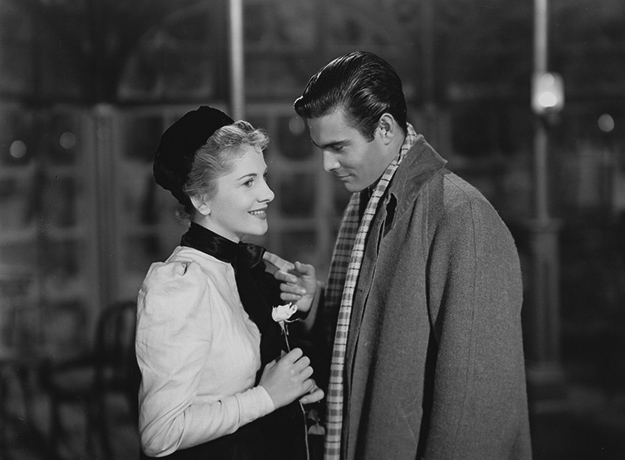
Could it be both? For if marriage is no longer as binding or as destiny-shaping as it once was, are we any less eager to find the one true love who will somehow “recognize” us and see us whole, a soulmate? And might this paradox explain why the film seems perpetually relevant? It’s true that what passed as heroic in one day and age, may appear absurd in another as definitions of courage and duty shift along with changing gender roles. Consider another heroine, Ibsen’s Nora, analogous to Lisa in her monomania: Where once the slamming of the door at the conclusion of A Doll’s House seemed, if not an unqualified triumph on the part of the exasperated, infantilized wife (too much was uncertain), at least an exhilaratingly bold gesture towards women’s equality. We hardly asked what happened next, so thrilled were we by the sheer audacity of it, and the way her departure spoke to women still indentured to domesticity. Now as I write this some 70 years later, we are asked to look back and take stock of the fallout of that decision: Lucas Hnath’s celebrated play, A Doll’s House, Part 2, forces us tolook at the pieces of a household in shreds. In this effective but wildly one-sided reckoning, a sort of male nightmare vision of feminism, it’s payback time: Nora has become a strident ideologue, unable to hear or sympathize with the emotions of others. A humiliated Torvald, an angry and subversive daughter, an embittered family retainer, these are the casualties of that heroic gesture of a woman’s liberation. No less a refusenik than Nora, Lisa twice rejects the security and comforts of a conventional married life, virtually ignoring the emotions of others in what she sees, or feels, as a higher calling, a compulsion that must be obeyed.
Some essayists have felt that Ophuls completely identified with his heroine and expected the same of his audience. It’s true he shared with his female characters a feeling of displacement, an alienation from the culture at large. Their preoccupation with fate and chance give their stories an air of ephemerality, a timelessness whether anchored in turn-of-the-century Vienna (Letter, La Ronde, Liebelei), a vaguely postwar America (Caught, The Reckless Moment), France, or the global reach of Lola Montès. But to see Lisa as wholly sympathetic is to miss the deep thread of irony that runs through the whole, and to ignore the finely drawn subsidiary characters, the even-handedness with which Ophuls regards the lives of those around Lisa.
In watching it again, I find that Stefan has become every bit Lisa’s equal, a vividly imagined lost soul as captivating as he is heartbreaking. Hardly less poignant though with little screen time are the son, Stefan Jr. (Leo B. Pessin), and the husband (Marcel Journet), one of those military men (like Charles Boyer in Madame de) whose conventional views and demeanor mask an obvious depth of feeling. Johann represents correct society, but also the ideals of duty and obligation, by no means trivial. He even married her with the full knowledge of her affair and the child’s parentage. Indeed, she will be urging the boy to call Johann Father even as she is leaving him forever, leaving a ten-year-old Stefan who needs and can appreciate her love for the adult and dissipated Stefan who can’t. And here’s the crux of it: if Stefan repeatedly fails to see her clearly, fails to recognize her as the savior who might redeem his life and vocation, so she fails to appreciate the unlikelihood of his transformation, and especially the depth of his degradation at the end. Rarely has the nature of love as fantasy been so richly understood or so exquisitely expressed.
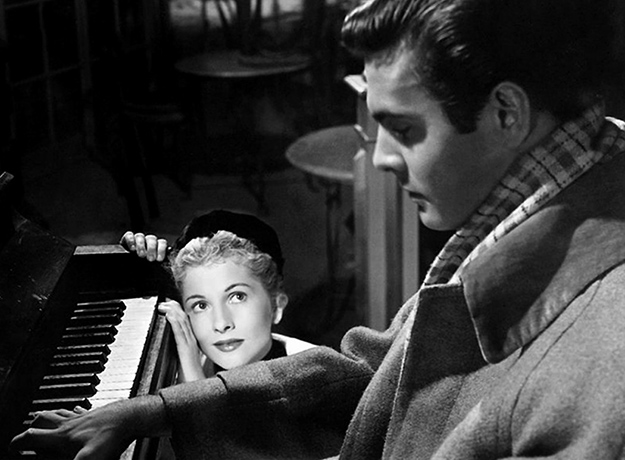
As a backward teenager, Lisa conceives a passion for Stefan almost before she lays eyes on him. The exquisite art objects that will decorate his apartment in her Viennese building precede his arrival and the sound of his piano playing after he is installed (Liszt’s plaintive Un sospiro) enrapture her ears before the dashing musician makes an appearance. (In Zweig’s novella, he’s a writer, and it is his books that first excite her interest, she even imagines him a wise old man.) In Ophuls’s version, music will play a role equal to the images, and, in concert with Ophuls’s famous tracking shots, sometimes underline an emotion, and at other times provide counterpoint.
Lisa blushes when caught out by her saucy girlfriend, a girl already alert to any whiff of sexual byplay, a typical Ophulsian foil who fails to understand the depth of Lisa’s infatuation, its qualitative difference from the ordinary schoolgirl crush. As zealously as a nun taking religious vows, Lisa will dedicate herself to this love, will train and educate herself, learn to dance and dress; when her mother remarries and moves to Linz, she will leave the safety of the maternal home, move back to Vienna, work as a dressmaker’s model and live to be near the object of her devotion. Ophuls’s cinema is populated by women who begin as dangerously empty vessels and then take on their definition in relation to men, mirrors reflecting them back to themselves in magnified versions (Lola Montès), or trying, in turn, to become their ideal woman. This takes the form of a self-education that can go dangerously awry as in the director’s darkly comic Caught, made the following year, in which a car hop played by Barbara Bel Geddes, attends charm school to learn how to walk and talk and flirt, the goal being marriage, preferably to a man of wealth.
Night after night, Lisa, now an adult with a day job, will hang outside Stefan’s apartment shrouded in black, a virtual stalker, as he merrily goes on his evening rounds, taking no more notice of her than if she were a lamppost. Then one night as she lurks in the shadows, she will finally snag his roving eye. The camera moves in and finds her face, which, like a phototropic plant responding to the sun, lights up, her radiant womanly beauty now on full display, a revelation. It’s hard to imagine any other actress in this part, achieving this sort of transformation. Fontaine—as she showed in Rebecca—can be homely and beautiful, shrunken with timidity, or glowing with the passion of idolatry. The camera now follows the couple, in one of Ophuls’s trademark tracking shots, suggestive of deepening feeling as well as isolation from the scrambling human activity around them. Andrew Sarris said that Ophuls “gave camera movement its finest hours in the history of cinema,” but understood it was never for its own sake. However practical it may have been (Ophuls maintained it was to put awkward actors at ease) the effect was complex and double-edged. With ineffable grace, the lovers create their own private world, but the inexorability of the movement takes on a certain morbidity, as if they were simultaneously frozen in time, and the present were already sliding into memory. They will dine, laugh, commune, go to an amusement park and a dance hall, and finally (off camera) spend the night together.
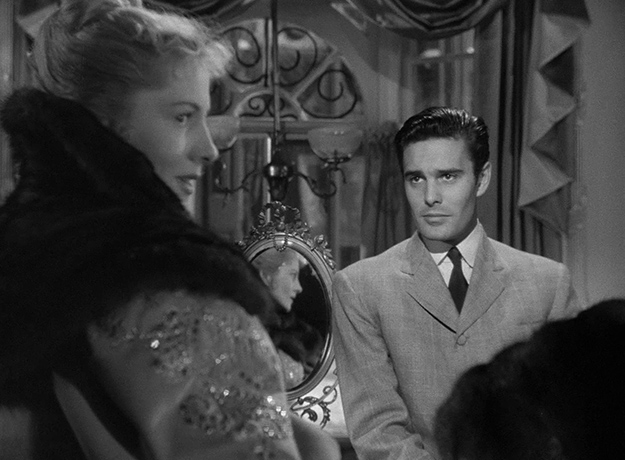
Of this incandescent date, Ophuls creates one of the most memorable sequences in all of cinema, collapsing space and time as Lisa and Stefan journey through a two-dimensional Europe in a railway carriage. In a kind of apotheosis of cinema itself, the couple seem to be sharing an entire lifetime as faraway places pass before their eyes, an imaginary courtship and honeymoon—out of which a real child is born. Lisa will give birth alone, refusing to divulge the father, refusing to ask Stefan for help. It is in moments like these that she refutes the charge of masochism (or perhaps expands it): she refuses to let us see her as a victim. In the course of a ten-year period, she will marry her rich Johann, achieve a certain domestic tranquility and then, seeing her beloved Stefan at a concert, fall all over again into the inescapable and as she sees it predetermined vortex of her passion, will leave husband and adored son, in one last futile attempt to make the musician, now dissipated, his concertizing career in shreds, recognize her and his need for her. The tragedy is that recognition does come, and redemption, but only by means of the letter that concludes with the death of the child and its mother, thereby determining an equivalent fate—the deadly duel—of its recipient.
The whole question of recognition: will he ever truly see her, remember her? provides the movie’s suspenseful leitmotif, its insight into the drama of love’s blindness. Ever at cross purposes, the two illustrate the difficulty of seeing another person whole, undistorted by subjective fantasies. For better and worse, Ophuls seems to be saying, we are trapped inside our own imaginations.
In a lovely exchange during the enchanted nighttime excursion, he tells her he prefers the amusement park in winter when nobody’s there, rather than the summer when it’s crowded, and she says, that’s because you prefer to see it in your imagination. He is stunned by her insight. Often she seems—as he eagerly admits—to see into his soul, to identify his weaknesses and intuit his yearnings. But she proves to be living in her imagination no less than he. Yes, like many a weary Ophulsian hero he yearns for sincerity, for the pure and innocent woman. (In Liebelei, the dashing soldier turns away from his aristocratic mistress in favor of the simple girl played by Magda Schneider.) But that option has been rejected too often for it to carry any weight. The philanderer is like the serial killer, compelled to repeat his pattern; the woman, too, shares the pathology of the compulsive criminal, her sacred love the equivalent of his secret vice, both thrill to the sense of superiority it gives them over ordinary unsuspecting mortals.
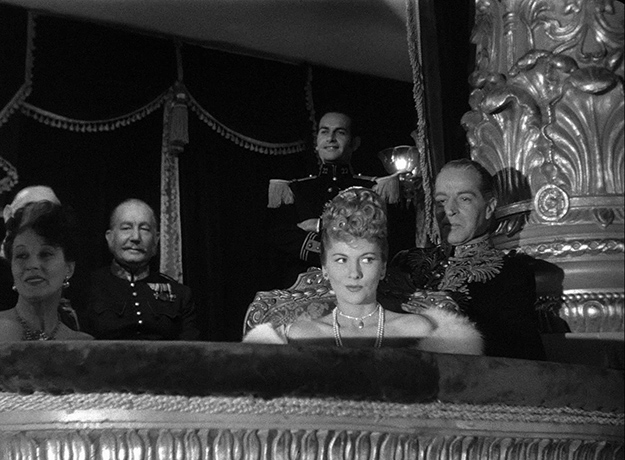
Ophuls arrived in Hollywood in 1941 and immediately felt cast adrift. Born in 1902 of German Jewish parents, he gravitated early to France and Vienna (directing plays and operettas). Fleeing Hitler’s Germany in the 1930s, he eventually left both land and language behind, making films in Italy, France and the Netherlands. But when he arrived in Hollywood he was without work for seven painfully idle years. The film community welcomed refugees like Lubitsch, Wilder, and Fritz Lang but didn’t always know what to do with these gifted cosmopolites until gradually the Europeans found ways to elevate movies with their European sophisticated style and sensibility. Letter came to him via screenwriter Howard Koch’s brilliant adaptation of the Zweig novella, with producers John Houseman and the team of William Dozier and wife Joan Fontaine.
Koch and Ophuls got along famously, and thanks to all of these eminent figures as well as cinematographer Franz Planer and the legendary art director Alexander Golitzen, he was able to recreate one of his most opulent sets to evoke turn of the century Vienna, a place already congenial to him (as in his adaptation of Schnitzler’s La Ronde), that conjures up worldliness, culture, music, and also a sort of ephemerality and make-believe. Inevitably imbued with retrospective knowledge of two convulsive European wars, of the Anschluss, and the city where Hitler would enact his first racial laws, Vienna’s dark streets and somber moods seem to anticipate the shuddering night to come. The musician, unnamed in the novella, is given the author’s first name in tribute, and the correspondences between Ophuls and Zweig are worth noting. Zweig, born into a prosperous Viennese Jewish family, became a best-selling writer in the twenties and thirties, then, fleeing Europe, an exile of renown, an urbane cosmopolite, until he emigrated to Brazil and was unbalanced by that very sense of impermanence and doom that pervaded his stories. The tragic undertow of all of Ophuls’s films—shadows that precede a permanent darkness—are eerily akin in atmosphere (brooding, penumbral); plot (obsessional but doomed love; missed opportunities); theme (lingering regret; the ever-present specter of what might have been; the sense of it always being “too late”) to the brooding atmosphere of Zweig, who like Ophuls, went into permanent exile, but failing to adapt, eventually killed himself at age 62 in South America.
Ophuls’s adaptation took the form of shaping his material visually and aurally, expanding what might have been seen as “novelettish” stories into something both grander and more intense, even multi-dimensional. He uses camera movement and perspective to chart the shift in a character’s position and point of view, so that we are both with and outside of them simultaneously. A prime example is the winding staircase in the apartment building where Lisa and Stefan live. Throughout the film she will climb and descend these stairs, and each stage is viewed from a slightly different vantage point.
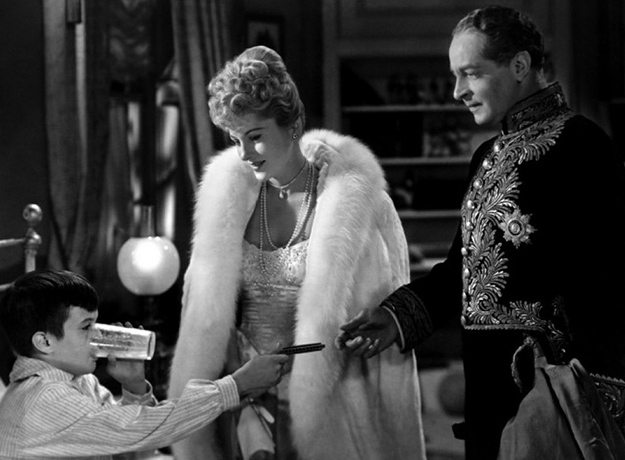
For Ophuls surfaces, objects, rituals are evoked as accouterments of bourgeois life, but that is just the beginning. Compare two opposing scenes which dwell on things: in Madame de Daniele Darrieux, desperate for something to pawn, passes her hand over jewels that have come to her through her marriage and are now divested of meaning. In Letter, by contrast, Fontaine, by visually caressing the objects in Stefan’s apartment, endows them with emotion, virtually sacralizes them. The bright sunlight of Linz with its brass band concerts, its military marches, where even the courting couples seem to be enacting a drill, contrasts with the penumbral world of Vienna, its alleyways and winding stairs, its smoky night clubs and hurdy-gurdy entertainments.
The pinnacle and, as it turns out, the nadir of Viennese aspiration and culture, exaltation and degradation, comes with the bravura visual choreography of the opera house scene, when, after a ten-year hiatus, Lisa spies Stefan again. Mozart’s Magic Flute is being performed; in the stalls and stairways, opera-goers gossip about Stefan Brand and his wasted talent. The roving camera finds each of them, enabling us to see both the reawakening of her passion and the dark circles under his beautiful, dissipated eyes.
Suddenly that horrible pick-up line (“I’ve seen you somewhere, I know”) takes on a kind of gallows humor, trite but also possibly true—we can’t be sure any more than he can (such are the difficulties of seeing) whether she’s a mirage or an actual memory. He continues to fumble —is she the life-changer he’d always thought would come to him? His bewilderment underlines the essential passivity of the male philanderer contrasted with the fiercely committed woman, so single-minded that she sees their meeting as foreordained: “The course of our lives can be changed by such little things… I know now that nothing happens by chance… Every moment is measured, every step is counted.” She knows she can no longer escape him, everything is in danger. “It was like the first time I saw you, the years begin melting away.”
Such is the alibi of the obsessional lover, reality no longer exists, one is possessed, an automaton. She puts her son on a typhus-infected train that consigns him to his death. She turns a deaf ear when Johann reminds her of her duty. “You have a will,” he insists, “you can do what’s right.”
This she denies, “I have no will but his, ever.” Johann sees what she cannot—that Stefan is almost certainly beyond the reach of her redeeming, rehabilitating love.
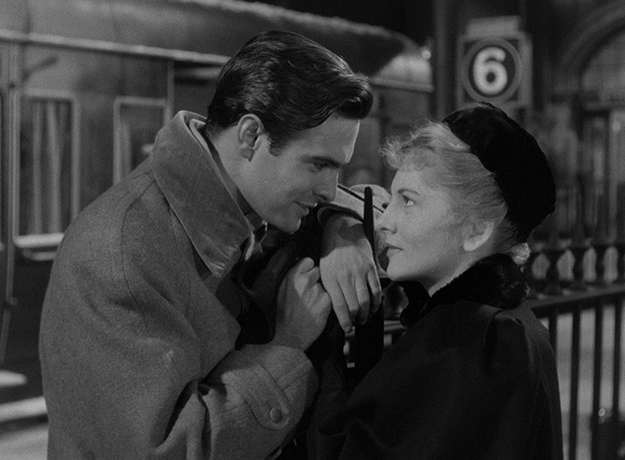
Ophuls’s portrait of love as subjective fantasy is after all, quite in keeping with the post-Freudian world in which we live. It was in Zweig’s Vienna that the father of psychoanalysis was interpreting the secret of dreams, and illuminating the role of the unconscious in fashioning an idealized beloved at the expense of reality. Freud led us to the unhappy understanding of the degree to which we are so often at war with our thinking, rational brains. Zweig believed in rationalism and the humanist tradition (he wrote a biography of Erasmus), yet his stories are filled with characters who helplessly and inexplicably sabotage their every chance at happiness. Ophuls’s angle of vision was more ennobling, but no less pessimistic.
The sense of being imprisoned in our own psyches finds eerie resonance when you know that Zweig’s mother had a mistreated ear problem, and was growing increasingly deaf during his childhood. She would leave their bustling and noisy household to go to the cinema, where she could read the titles and understand the movie. But the son didn’t know of his mother’s disability, only that she was distant, a woman seemingly living inside her own head!
For Zweig, yearning for a maternal response, love must have always felt just out of reach—a metaphor, however extreme, for the sometime-solipsism of love. Our aloneness in our fantasies remains a brutal truth, still rarely admitted. A stunning example of such an admission came in 2017, at the time of this writing, in a story crafted by women. In I Love Dick, the controversial Amazon series adapted by Jill Soloway from the book by Chris Kraus, Kathryn Hahn plays the frequently cringe-inducing writer heroine as she shamelessly pursues Dick, the charismatic Marfa artist-guru. At one point, in a soliloquy to her imagined lover, she says “I don’t care how you see me, I don’t care if you want me. It’s better that you don’t. It’s enough that I want you.”
The only thing wrong with this confession is that it is far too reasonable and clear-eyed to come from the lips of a woman in the fevered state of obsession. Nevertheless, it perfectly describes the condition of l’amour fou, or the exalted state, the addiction, in which Lisa nurtures a love that never has to undergo the trial of cohabitation, of compromise. How better to own your passion, keep it pure and undefiled, and thus in line with image of self as selfless love than unrequited love?! A love uncorrupted by the flesh, by crude commingling. There was nothing prudish about Ophuls, either in his films or his life (Koch wrote of his own friendly relations with both of the director’s households: one presided over by Mme Ophuls, the other by his mistress). In other films the adulterous couples clearly and happily find their way to beds, discreetly left unshown. But in the essentially asexual vision of romantic love, largely created, certainly aided and abetted by Hollywood censorship, the absence of sex only fuelled the heady fantasy of love as a meeting of twin spirits. If Letter from an Unknown Woman still speaks to us, it’s because, for all of our sexual freedom and supposed autonomy, many of us still secretly yearn to fall headlong into the drama of an all-encompassing, life-defining love. A love of soulmates.
Letter from an Unknown Woman is available in a new Olive Signature Blu-ray edition, featuring a version of this essay. It will screen as part of the Film Society of Lincoln Center’s “Emotion Pictures: International Melodrama” on December 16 and 26.
Molly Haskell is a film critic who has written for The Village Voice, New York Times, New York magazine, Vogue, New York Observer, The Nation, and The Criterion Collection. Her books include From Reverence to Rape: The Treatment of Women in the Movies (1974), Holding My Own in No Man’s Land (1997), Frankly My Dear: “Gone with the Wind” Revisited (2009), and Steven Spielberg: A Life in Films (2017). She has been a contributor to Film Comment for decades, most recently writing articles about Robert De Niro, Annette Bening, Elle, and Call Me by Your Name. In December 2017, the New York Film Critics Circle announced that Haskell would receive a Career Achievement Award for Criticism.







